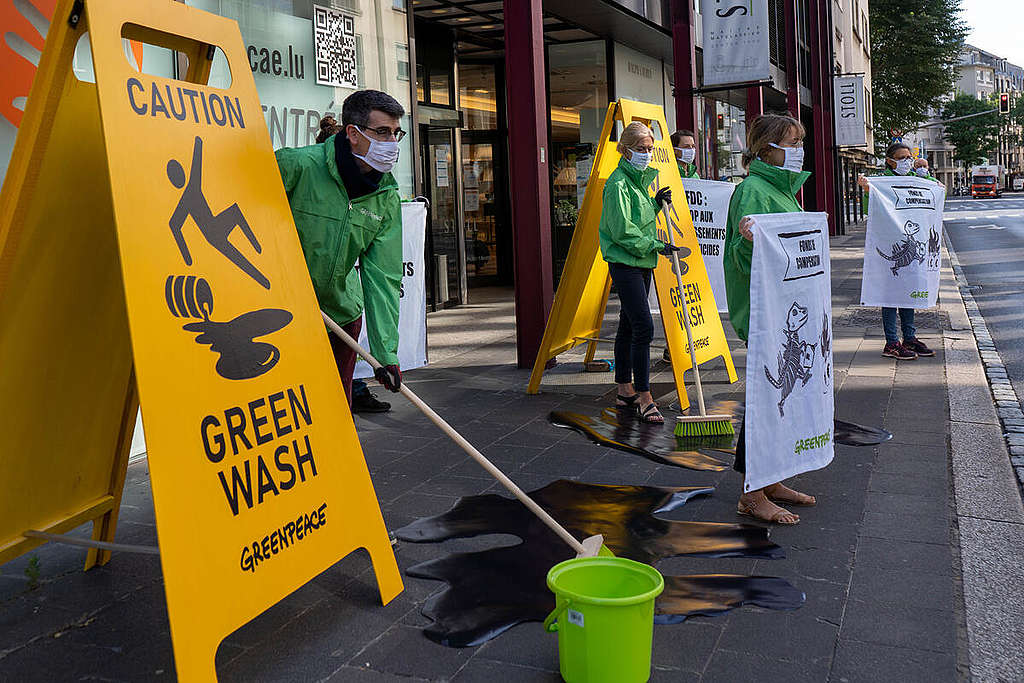This is a historic moment – a crisis that requires governments to act together in an unprecedented way to ensure a future for all life on Earth. It can all be done, if we only choose to do so.
Instead, what we are seeing from governments is a plethora of excuses, greenwashing, and inaction. Within the climate debate, the biggest deception comes down to a single word: net.

The problem with ‘net’
Counting things in a net way can be very helpful but it can also be totally misleading, like when the decline of our forests is counted as net forest loss, suggesting that clearing old growth forests can be compensated for by planting monoculture tree plantations.
This same deceptive approach is promoted in countless climate pledges of governments and corporations as ‘Net Zero’ or ‘Carbon Neutrality’. While the ambition in all these plans varies widely, they have one major flaw in common: the assumption that carbon safely stored in fossil fuels is equal to the carbon in the atmosphere, living organisms, top soils, and the oceans. It is not.
So how do carbon stores work?
Carbon in fossil fuels is permanently locked away and only contributes to climate change when humans extract and burn it. Once released from these stores, it constantly moves around circling between air, water, soils, and living beings, largely out of our control. Once in the atmosphere it heats up our climate so we must stop burning these fuels in the first place. In addition, we need to move carbon from the atmosphere to other places, for example trees and soils, if we are to stay within moderate climate heating scenarios.
As much as we need to invest in protecting and restoring, we should also not assume that these carbon stores are permanent. In a heating climate, forests increasingly die because of droughts, pests, and fires, while decay accelerates in soils releasing previously stored carbon. New forests also grow too slowly to help us stretch the carbon budget we have left.
Technological fixes, like Carbon Capture Storage (CCS), have not been proven to work at a large scale and are extremely costly. Other technologies like climate engineering and marine geoengineering schemes are even more risky. Plans that rely on CCS delay real climate action and have no guarantee of success. There is no other way to solve the climate emergency than immediate and massive reduction in fossil fuel emissions.
In the long term, we’ll need nature’s help to remove carbon from the atmosphere, as today’s level of atmospheric carbon already triggers processes that must not be allowed to reach a point of no return – their tipping point. Processes like the thawing of the permafrost, the dieback of the Amazon, or the disintegration of major ice shields in places like the Arctic.
What’s wrong with “Net Zero”?
Net Zero pledges are being released now on a nearly daily basis. They assume that emissions from burning coal can be compensated (or ‘offset’) in real time by protecting a forest or planting trees, ignoring the fact that plants need time to grow, whilst cutting fossil fuel emissions has immediate results.
Net Zero pledges also assume that there are no limits to compensate one’s own emissions with reductions or increased carbon removal elsewhere. They assume that adding up all Net Zero pledges would get us to the 2050 vision of globally not emitting more carbon than can be reabsorbed. But it won’t.
All these pledges compete for limited ways in which carbon uptake can be increased, like land for forest restoration. For example, if countries like Russia, with massive opportunities for reforestation, decide to go for Net Zero emissions only – relying on the restoration of forests instead of cutting fossil fuel emissions – this will not be enough to solve the climate crisis. In many places we will need to go far beyond ‘net zero’ to balance out the land restrictions in other places that limit opportunities for carbon removal.
The Net Zero approach is popular for one simple reason: it’s cheaper. Voluntary ‘carbon credits’ from schemes investing in forest protection or restoration can be bought for less than $10/tCO2. When a European power plant fails to comply with its mandatory emissions reductions targets, it needs to pay more than 5 times as much. In particular for corporations, carbon credits cost them a pitiful amount of money whilst they can continue their emission intensive business as usual, and still market themselves as a ‘climate champion’. This is not only bad for our climate, it’s unjust, as it often puts a massive burden on those marginalized communities most affected by the climate crisis.
What needs to happen to solve the climate crisis?
Actors must keep their plans simple and transparent, with separate targets for:
- Rapid reductions in emissions from the burning of fossil fuels and other industrial activities.
- Rapid reductions in emissions from land use impact, mainly from deforestation and via a reduction of meat & dairy production.
- Increased commitments and contributions to rights-based nature protection and restoration.
We need all sectors of society, from government to business to local communities and Indigenous Peoples, must work together in just and equitable ways to urgently solve this crisis. We are part of nature – if we protect nature we protect ourselves.
Maik Marahrens is a Senior Campaign Strategist Forests with Greenpeace International.



